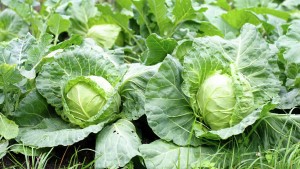- Houseplants
- 4,564
Cabbage is a nutritional powerhouse and an essential vegetable in many diets around the world. It is an easy vegetable to grow, but it does require some special care to ensure it grows to its full potential.
Here at Garden Pie, we shall look into how to care for Cabbage.
Table of contents [Show]
What you need to know about cabbage
Cabbage is a nutrient-dense vegetable, providing significant amounts of vitamins and minerals. It is a good source of Vitamin C, Vitamin A, Vitamin K, Vitamin B6, iron, magnesium, and dietary fiber. It also contains a variety of antioxidants and phytochemicals, which may help protect against disease.
It is believed to have numerous health benefits. It is high in antioxidants, which may help reduce inflammation and protect against certain diseases. Additionally, cabbage is high in dietary fiber, which can help reduce cholesterol levels and support digestive health. Cabbage may also help lower blood pressure, reduce the risk of certain types of cancer, and aid in weight loss.
Facts about cabbage includes:
- Name: cabbage, Brassica oleracea (Capitata group).
- Height: 30–50cm, depending on the variety.
- Plant type: annual leafy vegetable.
- Foliage: large, broad leaves that may be smooth or crinkled with a slightly waxy finish.
- Climate: tropical, sub-tropical, warm and cool temperate.
- Soil: moist, well-drained soil, enriched with compost and well-aged manure.
- Position: full sun, with protection from strong winds.
- Flowering: small yellow flowers.
- Feeding: liquid feed regularly throughout the growing season.
- Watering: water regularly.
Varieties of cabbage
Cabbage is a versatile and nutritious vegetable that is available in many varieties and can be used in a variety of dishes. Cabbage is a great source of vitamins, minerals, and fiber, making it an ideal addition to any healthy diet.
1. Savoy cabbage
Savoy cabbage is a type of cabbage that has crinkled, dark green leaves. It is mild in flavor and has a softer texture than other varieties. It is best used in salads and stir-fries and can also be steamed or boiled as a side dish.
2. Red cabbage
Red cabbage is a type of cabbage that has deep purple leaves. It has a sweet and tart flavor and is slightly crunchier than green cabbage. It is great for adding color to salads and slaws, and it can also be cooked and used in dishes such as stews and soups.
3. Chinese cabbage
Chinese cabbage is a type of cabbage that has pale green leaves and is slightly crunchier than other varieties. It has a mild and sweet flavor and is commonly used in stir-fries and salads.
4. Bok choy
Bok choy is a type of cabbage that has light green leaves and a mild and sweet flavor. It is commonly used in Asian dishes and can be stir-fried, boiled, or steamed.
5. Napa cabbage
Napa cabbage is a type of cabbage that has lighter green leaves and a mild flavor. It is commonly used in salads, stir-fries, and soups and can also be pickled.
6. Brussels sprouts
Brussels sprouts are a type of cabbage that have small, round heads and a slightly bitter flavor. They are often roasted, steamed, or boiled and can also be cooked in soups and stews.
7. Kale
Kale is a type of cabbage that has dark green leaves and a slightly bitter flavor. It is often used in salads, soups, and stews, and it can also be steamed and cooked in stir-fries.
Appearance and characteristics of cabbage
Cabbage is a popular vegetable that has been cultivated for centuries. It is a cruciferous vegetable that is part of the brassica family, which includes broccoli, kale, and Brussels sprouts. Cabbage is a cool-weather crop that grows in many parts of the world. It is an excellent source of vitamins and minerals, and it has many health benefits.
Appearance:
- Cabbage is a leafy green vegetable that can range in color from light to dark green, purple, or white.
- It has a round or oval shape and is usually about 6 inches in diameter.
- Its leaves are dense and tightly packed, and the outer leaves are usually larger than the inner ones.
Characteristics:
- Cabbage is a low-calorie vegetable that is high in fiber.
- It is a good source of vitamins A, C, K, and B6, as well as minerals such as calcium, potassium, and magnesium.
- It also contains phytonutrients, which are beneficial plant compounds that may help reduce the risk of certain diseases.
Cabbage is a versatile vegetable that can be eaten raw, cooked, or fermented, and it can be used in a variety of dishes. It can be sautéed, steamed, boiled, stir-fried, added to soups, or shredded and used as a salad. It is also a popular ingredient in fermented dishes such as sauerkraut and kimchi.
Cabbage is an easy-to-grow vegetable that can be grown in a garden or in containers. It prefers cool weather and prefers to be planted in loose, well-draining soil. It is a hardy plant that can tolerate some frost and can be harvested when the heads are firm.
How to use cabbage ?
Cabbage is a popular vegetable and an essential ingredient in many dishes, from salads and coleslaws to soups and stir-fries. Whether you're looking to add some crunch to your meal or want to make a meal that's totally vegetarian, this versatile veggie is a great choice.
Here's how to use cabbage in the kitchen:
- Choosing cabbage. When selecting cabbage at the store, look for heads that are firm and tightly packed. Avoid any heads that are limp or have discoloration.
- Preparing cabbage. Before you cook with cabbage, you'll need to prepare it. Rinse it well under cold running water and then cut off the core. Slice or shred the cabbage, depending on the recipe you're making.
- Cooking cabbage. Cabbage can be cooked in a variety of ways. It can be boiled, steamed, stir-fried, or even roasted in the oven. If you're boiling cabbage, make sure to add a little salt to the water to help bring out its flavor.
- Adding cabbage to recipes. Cabbage is a great addition to a variety of dishes. Try adding it to soups and stews, or use it as the base for a hearty salad. You can also use it to make classic dishes like coleslaw and sauerkraut.
- Storing cabbage. Cabbage can be stored in the refrigerator for up to one week. Wrap it in plastic wrap or place it in an airtight container to help keep it fresh.
With a bit of preparation and the right recipes, you can easily incorporate this versatile vegetable into your cooking.
How to grow cabbage ?
Cabbage is an easy vegetable to grow and can be planted in the early spring or late summer depending on the variety. Growing cabbage can be a rewarding experience and provides a great source of nutrition for your family.
Here are some tips on how to grow cabbage in your own garden:
- Choose the right variety of cabbage for your climate. Cabbage comes in a variety of shapes, sizes, and colors. Different varieties have different requirements for optimal growth, so research what type of cabbage will grow best in your region.
- Plant the seeds or transplants in well-drained soil that is rich in organic matter. Cabbage needs plenty of moisture to grow, so make sure the soil is moist but not soggy.
- Make sure the soil temperature is between 60 and 65 degrees Fahrenheit. Cabbage seeds will not germinate in cold soil, so wait until the soil is warm enough to plant the seeds.
- Space plants 12 inches apart, as they will need plenty of room to grow.
- Water the plants regularly, especially during hot, dry weather. Cabbage needs at least an inch of water per week.
- Fertilize the plants every four to six weeks with a balanced 10-10-10 fertilizer.
- Control weeds in the garden by hand-weeding or using a mulch.
- Harvest cabbage when the heads are firm and the leaves are full.
Caring for cabbage
Caring for cabbage is simple and straightforward, but there are a few key points to keep in mind in order to ensure the best harvest.
The first step in caring for cabbage is to choose the best location for planting. Cabbage prefers sunny, well-draining soil with a pH between 6.5 and 7.5. If you are planting in an area with heavy clay soils, it is best to add a few inches of compost or other organic material to help loosen the soil.
Once your soil is prepped, it's time to plant your cabbage. Planting can be done directly in the ground or in containers, depending on your preference. Plant seeds about 1/2 inch deep and 4-6 inches apart. Cabbage can be planted in early spring or late summer for a fall harvest.
Once your cabbage is planted, it's important to keep it well-watered. Cabbage likes consistent moisture, so make sure to water your plants on a regular basis. It's also important to fertilize your cabbage with a balanced fertilizer every two weeks. Compost or organic fertilizers are best, as they provide the plants with the nutrients they need without the risk of over-fertilizing.
Finally, it's important to keep an eye out for pests and diseases. The most common pests that affect cabbage are cabbage worms, caterpillars, and aphids. If you notice any of these pests, you can hand-pick them off or use an organic insecticide. Disease prevention is also key, so make sure to rotate your crops and keep the area around your plants clean and weed-free.
How often should you water and feed cabbage ?
Cabbage is one of the easiest vegetables to grow in your garden, but it does require proper watering and feeding to produce healthy heads. If you've ever wondered how often you should water and feed cabbage, then you've come to the right place.
Watering
- Cabbage needs to be watered regularly to ensure that the soil remains moist and doesn't dry out.
- Depending on the temperature and the amount of rain you receive, you should water your cabbage 1-2 times a week.
- Make sure to water deeply and thoroughly to ensure that the roots are getting enough water.
- If the cabbage is planted in a sandy soil, you may need to increase the frequency of watering.
Feeding
- Cabbage needs to be fed regularly to ensure that it is getting enough nutrients to produce healthy heads.
- A common fertilizer used for cabbage is a 10-10-10 fertilizer. Apply this fertilizer once a month, and water it in well.
- You can also add a layer of compost or manure around the plants to give them an extra boost.
These are some general guidelines for watering and feeding cabbage. While it's important to water and feed your cabbage, be sure to not overdo it, as this can cause nutrient deficiencies or root rot.
Diseases and pests that affect cabbage
Cabbage is Unfortunately prone to a variety of diseases and pests that can damage plants and reduce yields. To ensure a successful crop, it is important for growers to be aware of the different problems that can affect the health of their cabbage plants.
Diseases
1. Clubroot
One of the most common diseases that can affect cabbage is clubroot.
- This fungal disease is caused by the soil-borne pathogen Plasmodiophora brassicae, which lives in the soil and is able to survive for long periods of time.
- Symptoms of clubroot include stunted growth, yellowing leaves, and distorted roots.
- To prevent the spread of clubroot, it is important to rotate crops and avoid working in the garden when the soil is wet.
2. Black Rot
Another common disease that can affect cabbage is black rot.
- This bacterial disease is caused by Xanthomonas campestris and is spread through contaminated soil and water.
- Symptoms of black rot include yellowing of the leaves, wilting, and brown lesions on the stem and leaves.
- To prevent black rot, it is important to rotate crops, remove any infected plants, and avoid overhead irrigation.
Pests
- In addition to diseases, cabbage can also be affected by a number of pests. Flea beetles, aphids, and caterpillars can all feed on the leaves of the plant and can quickly cause damage.
- To deter these pests, it is important to use row covers and to remove any weeds or other vegetation from the garden.
How and when to harvest cabbage ?
Knowing when and how to harvest cabbage is key to getting the most out of your crop.
When to Harvest ?
- Most cabbage varieties are ready to harvest approximately 70-90 days after planting.
- To determine if the cabbage is ready, you should check the size of the head – it should be at least six inches in diameter. If the head is still small, it isn’t ready to be harvested yet. You can also check the firmness of the head – it should be firm and compact.
- If you're growing late-season cabbage, you can leave it on the plant for a few more weeks and it will continue to grow. However, you'll want to harvest it before the first frost of the season. Otherwise, the cabbage may become too soft and unusable.
How to Harvest ?
- The best time to harvest cabbage is in the morning when the plant is full of moisture.
- To harvest, carefully cut the cabbage head from the stem using a sharp knife.
- It's important to make sure you don't cut too close to the stem, as this can cause the cabbage head to become damaged.
- After harvesting, you'll want to get the cabbage to a cool place as soon as possible.
- Cabbage doesn't store well at room temperature, so you'll want to store it in the refrigerator or a cool, dark place.
How to propagate cabbage ?
Propagating Cabbage is a simple and cost-effective way to increase your crop. With a few simple steps, you can easily propagate cabbage and have plenty of cabbages for your salads and stir-fries.
- The first step in propagating cabbage is to choose the right variety. Cabbages come in many shapes and sizes, from round to cone-shaped, and from green to purple. Select a variety that is suited to your climate and soil conditions.
- Once you have selected the right variety, you will need to prepare the planting bed. Cabbage likes well-drained, nutrient-rich soil. Work in some compost or manure to ensure that your cabbage will have the nutrients it needs.
- Next, you will need to sow the seeds. Plant the seeds about 1/2 inch deep in the soil. Watering the soil regularly will help the seeds to germinate. When the seedlings are about 4 inches tall, you can thin them out so there is one plant every 12 inches.
- As the plants grow, you will need to keep them well watered and weed-free. When the plants reach maturity, it is time to harvest your cabbage. Cut the heads off just above the soil level, using a sharp knife.
- Once your cabbages have been harvested, you can save some of the seeds for the next season. To do this, allow the heads to dry out and then cut them open to remove the seeds. Store the seeds in a cool, dry place until you are ready to plant them again.
Conclusion
In this guide, you will learn that Cabbage is easy to grow and can be harvested throughout the growing season. In fact, It is a healthy and nutritious vegetable that is rich in vitamins and minerals and also low in calories, high in fiber, and can be used in many dishes.
Effective tips for caring for Cabbage
Cabbage like all vegetables needs to be cared for properly in order to enjoy it.
Here are 15 tips for caring for cabbage:
- Choose wisely. When selecting cabbage, be sure to choose a head that has tightly formed leaves and is firm to the touch. It should also be free from blemishes, discoloration, and soft spots.
- Keep it cool. Cabbage is a cool weather crop and should be stored at temperatures of 40-50°F. If storing cabbage in the refrigerator, be sure to keep it in the crisper drawer.
- Don't wash it until you're ready to use it. Washing cabbage before storing can cause it to spoil faster. If you do need to wash it, be sure to dry it completely before storing.
- Store it in the right place. Cabbage should be stored in a cool, dry place away from sunlight. If storing in the refrigerator, place it in the crisper drawer.
- Cut it the right way. To get the most out of your cabbage, cut it from the base of the core. This will ensure that the leaves stay together and are easier to use.
- Use it quickly. Cabbage is best when used within a few days of purchase. If you won’t be using it right away, try to use it within a week.
- Eat it raw. Cabbage is a great raw vegetable and can be used in salads or slaws. It also makes a great accompaniment to sandwiches and wraps.
- Cook it correctly. When cooking cabbage, it's important to not overcook it. Overcooking cabbage will cause it to lose its flavor and texture.
- Try it pickled. Pickled cabbage is a great way to enjoy the vegetable. It’s also a great way to preserve cabbage for longer periods of time.
- Freeze it. Freezing cabbage is a great way to preserve it for later use. It’s best to blanch the cabbage before freezing.
- Make coleslaw. Coleslaw is a classic dish made from shredded cabbage and a variety of other ingredients. It's a great way to enjoy cabbage when you don't have the time to cook it.
- Make sauerkraut. Sauerkraut is a traditional German dish made from fermented cabbage. It's a great way to enjoy cabbage and get some probiotic benefits as well.
- Make kimchi. Kimchi is a traditional Korean dish made from fermented cabbage and a variety of other ingredients. It's full of flavor and a great way to enjoy cabbage.
- Grow your own. Growing your own cabbage is a great way to enjoy fresh, healthy cabbage. It’s also a great way to save money and have control over the quality of your cabbage.
- Compost it. When you're done with your cabbage, don't throw it away! Composting is a great way to recycle the nutrients in cabbage and help your garden.




